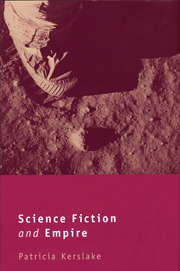Book contents
- Frontmatter
- Contents
- Introduction
- 1 The Self and Representations of the Other in Science Fiction
- 2 Resistance Is Futile: Silencing and Cultural Appropriation
- 3 The Word for World Is Forest: Metaphor and Empire in Science Fiction
- 4 Things Fall Apart: Relativity, Distance and the Periphery
- 5 Moments of Empire: Perceptions of Lasswitz and Wells
- 6 Exoticising the Future: American Greats
- 7 The Shape of Things to Come: Homo futuris and the Imperial Project
- 8 A Postcolonial Imagination: Kim Stanley Robinson's Mars
- 9 Beyond Empire: Meta-empire and Postcoloniality
- Conclusion
- Notes
- Bibliography
- Index
8 - A Postcolonial Imagination: Kim Stanley Robinson's Mars
- Frontmatter
- Contents
- Introduction
- 1 The Self and Representations of the Other in Science Fiction
- 2 Resistance Is Futile: Silencing and Cultural Appropriation
- 3 The Word for World Is Forest: Metaphor and Empire in Science Fiction
- 4 Things Fall Apart: Relativity, Distance and the Periphery
- 5 Moments of Empire: Perceptions of Lasswitz and Wells
- 6 Exoticising the Future: American Greats
- 7 The Shape of Things to Come: Homo futuris and the Imperial Project
- 8 A Postcolonial Imagination: Kim Stanley Robinson's Mars
- 9 Beyond Empire: Meta-empire and Postcoloniality
- Conclusion
- Notes
- Bibliography
- Index
Summary
With the publication of his book Red Mars (1993), Kim Stanley Robinson (1952–) began a fictional debate on the phenomenon of the imperial project in a supposedly postcolonial era. His next two novels, Green Mars (1994) and Blue Mars (1996), completed the 1,700 pages of a trilogy that skilfully reflected the Western process of discovery, first landing, colonisation, exploitation and eventual colonial revolt, encompassing the macro of the imperial act in the micro of fiction. Though an ongoing recital of the imperial project is a fundamental theme of the SF genre, Robinson's meticulous realism reprises the process of empire to such a degree that his works may be considered important pieces of mainstream fiction as well as seminal works of SF, the New York Times calling the trilogy ‘a landmark in the history of the genre’.
Based on the colonisation and gradual terraforming of Mars, the trilogy charts the progress of the ‘First Hundred’, the original 100 scientists, engineers and explorers who begin the colonisation project. Though latterly joined by other pioneers and migrants, the actions of this initial group act as an anchoring thread throughout the timeline covered by Robinson's narrative. Opening in the year 2026, with the selection of the privileged few who will be the first to undertake interplanetary migration, this massive thought experiment of Robinson describes an immense circle, ending in 2206, at which point humanity is beginning a tentative flirtation with interstellar travel.
- Type
- Chapter
- Information
- Science Fiction and Empire , pp. 146 - 167Publisher: Liverpool University PressPrint publication year: 2010



